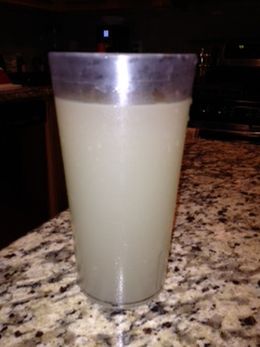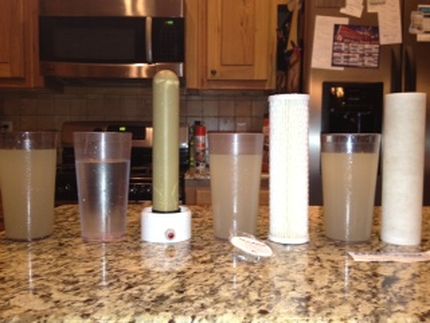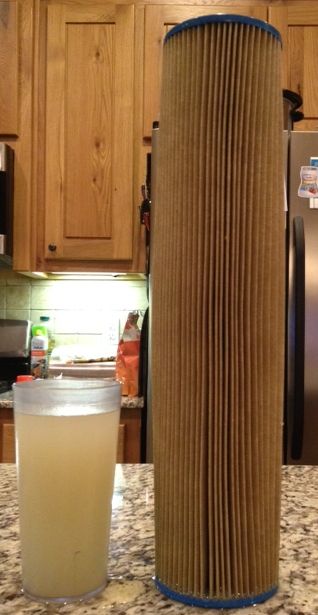Special Mid-Month Issue January 15, 2011 Read This Issue on the Occasional's Website |
|---|
Electro-Adhesion Filter Technology: NanoCeram Filters
by Gene Franks
Introductory Note: This short piece introduces a product we've had for a while, NanoCeram, but haven't done much about promoting. Here we present an informal test of the product's fine sediment reduction capabilities. The manufacturer of NanoCeram is the Argonide Corporation. The promotional material is adapted from a variety of Argonide Corporation sources.
The effectiveness of traditional sediment filters to remove contaminants is based on the pore size of the filter media. The smaller the pore, the tighter the filter. Filters that rely on the relatively new technology called electro-adhesion can remove particles that are actually smaller than the pore size of the filter.
This property has the great advantage of extra fine filtration combined with flow rates associated with less restrictive filters.
An electro-adhesive filter, therefore, with flow properties of a two to three micron pleated sediment filter can be capable of removing a wide range of smaller- than -two-micron water borne contaminants including bacteria, cysts, viruses and colloidal particles. It is the process called 'electro-adhesion' that allows the 2 micron filter to trap fine and ultra-fine particles down to an incredible 0.02 microns.
How Electro-Adhesion Works
Here's how the Argonide Corporation, maker of NanoCeram, a leading electro-adhesion filter, explains the process:
Electroadhesion utilizes the difference in charge that may exist between a surface (or fiber) and a
particle in an aqueous solution, where a charge is built up by the double layer effect. The zeta
potential is a measure of the driving force between the particle and the fixed surface, acting to attract
or repel the two. Most bacteria and most other particles are electronegative in water. Smaller
particles also tend to become more electronegative. So an electropositive fixed surface would be far
more effective at attracting and retaining particles than one that is electronegative. Another factor is
the area of solid surface that is exposed to the particles in the fluid. One with a large surface area
can support more electropositive charges and therefore adsorb more particles.
The most common application of the electro-adhesion technology is in the form of a standard pleated filter cartridge. Pleated filters offer greatest surface surface area and provide a perfect delivery mode for electro-adhesion. The result is a filter that has 2 to 3 micron physical filtration capability, but with the application of nano technology it can trap fine and ultra-fine particles down to 0.02 microns.
The resulting filter has a very high theoretical performance. The manufacturer claims it can:
Remove >99.9999% at 0.2 microns.
Remove>99.997% at 0.02 microns (Virus level)
Remove heavy metals like copper, iron, lead and tin.
Operate at a pressure drop comparable to that of a two to 3 micron filter.
Function in a broad pH range--pH 4 to pH 9.
Demonstrate a dirt-holding capacity up to 25 times that of conventional sediment filters.
Effectively treat viral and bacterial microbes.
Filter electro-negatively charged proteins, endotoxins, DNA, RNA--sub-micron and nano-size organic and inorganic particles.
Resist clogging and offer greatly extended filter life and minimal pressure drop.
Support very high flow rates per cartridge size.
An Informal Field Test in Sediment Reduction
Our customer Jeff gets his household water from a pond in North Texas. The pond is usually reasonably clear, but rain muddies it with a very fine clay-like sediment. He treats the water with a 5-micron Micro Z (ChemSorb) backwashing filter and a 5 micron wound string sediment filter, then he chlorinates it with a non-electric Chemilizer pump, sends it to settle in a large holding tank, then sends it through a carbon block filter and finally a Watts UV unit as a final protection from bacteria. This works well most of the time, when the water is clear.
When the water is muddy, it has very small particles that easily pass through the two five micron filters. The water looks like this, even after basic filtration.
 |
|---|
| Muddy Pond Water, after filtration through a Micro Z backwashing filter and a nominal 5 micron sediment filter. |
As a test, Jeff ran his 5-micron filtered muddy pond water through three test filters that we provided: a Doulton Sterasyl ceramic candle, a one-micron (nominal) depth filter, and a pleated NanoCeram electro-adhesive cartridge. The initial test was done "full speed"--at a high flow rate, to challenge the filters. (With the ceramic filter, "full speed" is only about a gallon per minute.) The picture below shows the result.
 |
|---|
Muddy Pond Water after filtration through Micro Z filter and 5 micron sediment filter is in the glass on the left. The glass on the right is the same water filtered through a nominal 1-micron melt blown sediment filter. The water in the center glass has been processed through a NanoCeram electro-adhesive filter (second from right). Finally, the second-from-left glass is water filtered through a Doulton Sterasyl Ceramic Candle. There's no doubt that the Doulton water is clearer, but the flow properties of the NanoCeram were far superior. |
Here's a subsequent test run, comparing the performance of just the 1-micron melt blown and the NanoCeram, with flow rate reduced:
| Running at reduced flow rate, the NanoCeram (left) as compared with the 1-micron melt blown cartridge (right). |
Discussion
Jeff's pond water represents one of the hardest problems in residential water treatment.
Municipal water suppliers faced with tiny colloidal particles that pass through conventional filters use chemicals like alum to promote "flocculation." The chemical alters the electrical charge of the tiny suspended colloidal particles allowing them to adhere to other particles and form larger-sized clusters that can settle out of the water or be removed by conventional filtration. Similarly, alum is sometimes employed in swimming pools to clarify cloudy pool water.
For residential water use, however, chemical flocculation can be a difficult and expensive undertaking, requiring large holding capacity, expensive chemicals, considerable expertise, and a lot of work. For example, for alum to work properly, the water's pH must usually be amended and held at a constant 7.0. This is difficult enough in the closed system of a swimming pool, but treating hundreds of gallons per day of muddy pond water would require great expense, patience, expertise and a full-time water employee.
The tests described above were done with 2.5" X 9.75" inch, drinking water size, cartridges. Whole house treatment, of course, requires larger equipment. The uncontested "winner" in the clarity contest, the Doulton ceramic candle, is capable of reliable bacteria removal, but is normally used at around 1/2 gallon per minute. It isn't suitable for whole house water treatment. It also has limited surface area (as compared with a pleated filter) and clogs quickly.
Jeff did a subsequent test with a full flow cartridge, a Flow Max 1-micron pleated filter, with the result shown below. The short life of the cartridge under adverse pond water conditions illustrates the dilemma.
We were hoping that NanoCeram, in a large format filter, would provide a suitable treatment for very fine particulate in residential water. . Our brief test doesn't indicate that it is capable of clarifying really challenging water like Jeff's, but it definitely improves it. We weren't able to test the superior dirt-holding capacity claimed by the manufacturer.
NanoCeram is sold on the "pay more to save money" concept. The cartridges are intended for much longer life because they have exceptional dirt holding capacity as compared with standard sediment cartridges. The theory is that although the initial cost is more, they cost less over time because they have many times the holding capacity of conventional pleated cartridges.
 |
|---|
| Test with 4.5" x 20" Flow Max Pleated Nominal 1 Micron Cartridge. Note the condition of the cartridge after treating around 400 gallons of pre-treated pond water. |
Pure Water Products now has NanoCeram cartridges in the four popular sizes. NanoCeram also manufactures a pleated carbon filter with electro-adhesive properties. We are not stocking it at present.
NanoCeram Pricing
| Part Number | Cartridge Size | Price (all PWP prices include standard UPS shipping). Prices are subject to change. |
|---|---|---|
| FC031 | 2.5" X 9.75" | $55 |
| FC214 | 2.5" X 20" | Call 940 382 3814 for pricing. |
| FC357 | 4.5" x 10" | Call 940 382 3814 for pricing. |
| FC475 | 4.5" X 20" | Call 940 382 3814 for pricing. |
The Pure Water Occasional is a project of Pure Water Products. Please visit our websites: Main Website: www.purewaterproducts.com. This site features our full range of products, plus instructions, technical articles, product manuals, and more. The Occasional's Website: www.purewateroccasional.net. In addition to archiving back issues of the email Occasional, this site houses a sizeable section about water contaminants, a "how things work," series, a new products section, a glossary of water treatment terms, and, "much, much more." Other Pure Water Products Sites: www.purauv.com To contact us by phone, please call 940 382 3814.
|
|---|